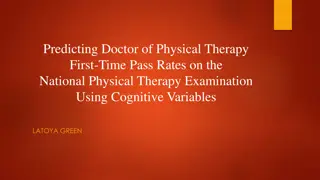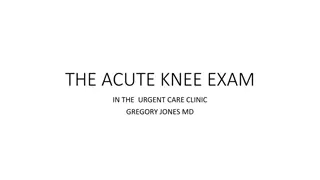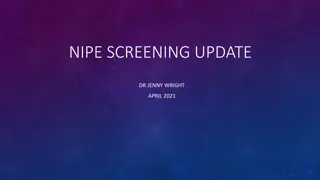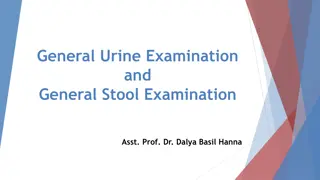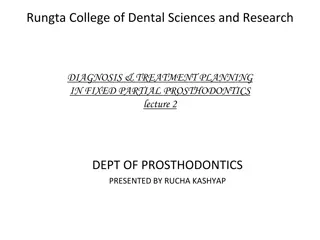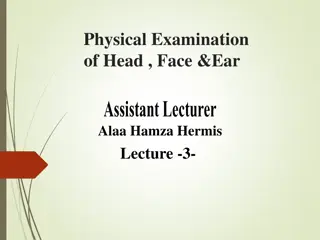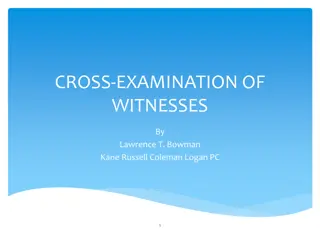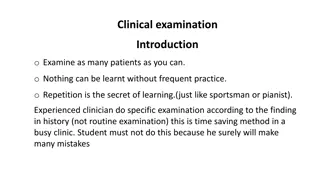Understanding Physical Examination: Importance and Purpose
Physical examination plays a crucial role in assessing a patient's physical and mental well-being, detecting diseases early, and establishing a good doctor-patient relationship. It involves systematically collecting objective information through examination techniques. The examination helps identify potential health issues, update necessary immunizations, and ensure overall health maintenance through regular check-ups and evaluations. By conducting physical assessments, healthcare professionals can determine the cause, extent, and nature of diseases, as well as monitor changes in a patient's condition. The process helps in providing necessary treatment and care tailored to the individual's needs.
Download Presentation

Please find below an Image/Link to download the presentation.
The content on the website is provided AS IS for your information and personal use only. It may not be sold, licensed, or shared on other websites without obtaining consent from the author. Download presentation by click this link. If you encounter any issues during the download, it is possible that the publisher has removed the file from their server.
E N D
Presentation Transcript
physical assessment physical assessment
INTRODUCTION It is the process of examining the patient s body to determine the presence or absence of physical problems. The goal of the physical examination is to obtain valid information concerning the health of the patient . The examiner must be able to identify, analyze, and synthesize the accumulated information into a comprehensive assessment
DEFINITION- Physical Examination is Defined As a complete assessment of a patient s physical and mental status. or A Physical assessment is the systematic collection of objective information that is directly observed or is elicited through examination techniques.
INDICATION OF HEALTH EXAMINATION On admission. On discharge. On follow up. Health camps. Before and after diagnostic and therapeutic procedure
PURPOSE:- To understand the physical and mental well being of the child. To detect diseases in its early stage. It is also gives a chance to talk to child about on-going pain or symptoms.
CONT.. According to the National Institutes of Health, these exams are used to: check for possible diseases, so they can be treated early identify any issues that may become medical concerns in the future update any necessary immunizations . ensure that you are maintaining a healthy diet and exercise routine.
CONT To understand the physical and mental well being of the clients. To detect diseases in its early stage To determine the cause and the extent of the disease. To understand any changes in the condition of diseases To determine the nature of the treatment or nursing care needed for the client. To find out whether the child is medically fit or not for a particular task.
IMPORTANT ASPECTS OF PHYSICAL EXAMINATION IMPORTANT ASPECTS OF PHYSICAL EXAMINATION: The examiner should continue speaking to the patient. Showing care to his disease and answer to patient s questions. It can not only release patient s nervousness, but also help to establish the good physician- patient relationship
THE FOUR CARDINAL PRINCIPLES OF PHYSICAL THE FOUR CARDINAL PRINCIPLES OF PHYSICAL EXAMINATION EXAMINATION:- Inspection. Palpation. Percussion. Auscultation.
PREPREPARATION FOR ASSESSMENT PREPREPARATION FOR ASSESSMENT Examination Room Equipment s. Position.
NURSE PREPARATION METHODS OF ASSESSMENT NURSE PREPARATION METHODS OF ASSESSMENT Inspection Palpation Percussion. Auscultation. Vital Parameters General Markers. Disease. Examination Assessment
PRE PRE- -PREPARATION FOR ASSESSMENT PREPARATION FOR ASSESSMENT EXAMINATION ROOM settings -Room must be warm. well-lighted and comfortable.
EQUIPMENTS EQUIPMENTS Stethoscope. Torch Light. Measuring tape(inches). Weighing machine. Spatula. Sphygmomanometer. Clinical thermometer. Red ring & blocks (for developmental assessment)
POSITION- Children between 3mnths 1year should be allowed to sit in mother s lap. 1year-3 years should be in the standard required position on examination table.
NURSE PREPARATION NURSE PREPARATION- - Informed Consent. Hand Washing. Warming of hands. Communication Skills. Avoid white apron. Small handy toys. Eye to Eye contact. Privacy
METHODS OF ASSESSMENT METHODS OF ASSESSMENT INSPECTION- It is the systematic visual examination of the client or it is the process of performing deliberate purposeful observations in a systematic manner. It involve observation of the colour, shape, size, and movements. It also uses the sense of smell to detect odour and sense of hearing to detect sounds. General Inspection. Overall appearance of health or illness. Signs of distress. Facial Expression and Mood. Body Size. Grooming and Personal Hygiene
PALPATION PALPATION It is use of the hands and fingers to gather information through touch. It is the assessment technique which uses sense of touch. It is feeling the body or a part with hands to note the size and position of the organs. Temperature, turgor, texture, moisture, vibrations, size, position, masses and fluid. . The palmar (Front) surfaces of the fingers and finger pads are used to assess texture, shape, fluid ,size, consistency and pulsation. Vibration is palpated best with the palm of the hand.
PERCUSSION PERCUSSION It is the examination by tapping the fingers on the body to determine the condition of the internal organs by the sounds that are produced. Percussion is the act of striking one object against another to produce sound. The sound waves produced by the striking action over body tissues are known as percussion tones or percussion notes. Percussion is also used to determine if a structure is air filled, fluid filled or solid.
AUSCULTATION AUSCULTATION- - It is the process of listening to sounds that are generated within the body. Auscultation is usually done with a Stethoscope. The heart and blood vessels are auscultated for circulation of blood, the lungs are auscultated for moving air (Breath Sound), The abdomen is auscultated for movement of gastrointestinal contents (Bowel Sounds)
HEAD TO TOE ASSESSMENT HEAD TO TOE ASSESSMENT VITAL PARAMETERS- Temperature. pulse. Respiration Blood pressure. Capillary refill time. Hydration. Oxygen saturation
GENERAL MARKERS OF DISEASE - Pallor. Cyanosis. Clubbing. Lymphadenopathy
HEAD TO TOE ASSESSMENT HEAD TO TOE ASSESSMENT- - Assessment of the patient begins on the first contact.it includes apparent state of health , level of consciousness, and signs of distress. The general height, weight, and build can be noted including skin colour, dressing, grooming, personal hygiene, facial expression, gait, odour, posture. vital signs assessment of vital signs is the first in physical assessment because positioning and moving the client during examination interferes with obtaining accurate results. Specific vital signs can be also obtained during assessment of individual body system.
CONT.. Hair and scalp - assess and note type of hair i.e. long, coarse, thick, brittle. Note the colour, distribution, quantity, thickness, texture and lubrication. On inspection separate the hair to determine the scalp. Wear clean gloves if lesions and lice are probable. Nails - the condition of the nails reflects the general health, state of nutrition, occupation, and level of self-care. nail biting can reveal the person s psychological state inspect the nail bed for colour, cleanliness, length, texture, angle between nail and nail bed and folds around the nail.
CONT. Head and neck- the assessment of the head includes: - eyes, ears, nose, mouth and pharynx. The assessment of the neck includes: - lymph nodes, carotid artery, thyroid gland and trachea. Eyes - visual acuity, position and alignment of the eyes, eyebrows and eyelids. note any abnormal discharges and color of conjunctiva and sclera. Ear- Integrity Of The Ear Structures And Hearing Acuity. Inspect For Sore And Discharges
CONT Nose and sinuses-Assess the integrity of the nose and sinuses by using inspection and palpation. Nose Observe for shape, size, skin colour, and presence of deformity or inflammation. Sinuses The exam involves palpation. Incise of allergy or infection the inside is inflamed and swollen so palpate for tenderness Mouth and pharynx -Assess mouth and pharynx to determine overall health and hygiene. Use pen light and tongue depressor to assess oral cavity. Inspect lips for colour, texture, hydration, contour, sores and lesions.
CONT.. Buccal mucosa, gums, and teeth -Ask client to clench teeth and smile to observe to observe teeth occlusion, symmetry. A symmetrical smile shows normal nerve function. Inspect teeth for hygiene, position, and alignment. Let client open with lips relaxed, use tongue depressor to inspect the mucosa for color, moisture and sores. Inspect gums for color, oedema, retraction, bleeding and lesions
CONT Tongue and floor of mouth Carefully inspect tongue on all sides as well as floor of mouth for colour, size, position, texture, moisture sores and lesions. Palate Have child extend the head backwards, holding the mouth open, inspect the hard and soft palate for colour, shape, texture and extra bonny.
CONT Pharynx the child tip the head back slightly, open mouth wide and say Ah , with penlight inspect the uvula and soft palate, and Check the uvula and tonsils for redness and inflammation.
CONT Neck Palpate the muscles, lymph nodes, carotid artery jugular veins for tenderness and distention. Thyroid gland ask client to hyperextend the neck and view the thyroid and palpate for masses. Normally thyroid gland is not visible. Chest Inspect the skin for scars, sores, colour, lesions, chest, movement and respiratory rate. Palpate to notice any masses, and tenderness in axillae and breast. Lungs Auscultate to assess respiratory and sounds from the lungs and chest cavity. Percussion is done to detect accumulation of fluid or air in the chest cavity.
CONT.. Heart Auscultate to hear the heart sound. Learn to know the normal heart sound to be able to detect the abnormal Breast. Inspect the breast for skin colour, scars and lesions. Palpate to notice any presence of masses. Extremities Upper and lower extremities Inspect hand and legs for symmetry, alignment, skin colour, temperature, sores, scars, lesions inflammation and varicosity. Palpate for tenderness, oedema and pulsation of arteries. Use the brachial, radial, ulna, femoral, popliteal, posterior tibia and dorsalis pedis pulses. Check capillary refill on nails, clubbed toes /fingers and joint mobility.
CONT.. Deep tendon reflexes Normally done on high risk patients and needs specialized practice and special hammer to assess the reflexes. Areas that are assessed are on biceps, triceps, patella, and Achilles. Abdomen Inspect the skin for colour, sores, lesions, scars, position of umbilicus, distention and contours. Palpate for tenderness, masses and enlargement of other organs like liver, spleen and kidney. Ask for bowel and bladder elimination. Percussion is used to detect the location of organs that are normally palpable e.g. liver, spleen and intestines. Always auscultate before palpation or percussion because touching can alter.
CONT Genitalia -Start assessment of presence of abnormal discharge, sores, warts and itching. rectum and anus inspect for the skin colour, sores, haemorrhoids and lesions. Do digital palpation examine the anal canal for masses and sphincters function only when important
CONCLUSION CONCLUSION- - Physical examination is the process of evaluating objective anatomic findings through the use of observation, palpation, percussion, and auscultation. ... The physical examination, thoughtfully performed, should yield 20% of the data necessary for patient diagnosis and management.
BIBLIOGRAPHY 1. Marilyn Hockenberry, David Wilson ,2009, Essentials of Paediatric Nursing, (8) Edition.P-95-143. 2. Potter. Perry, Fundamentals of Nursing, 7th edition (2009) Mosby Elsevier.





